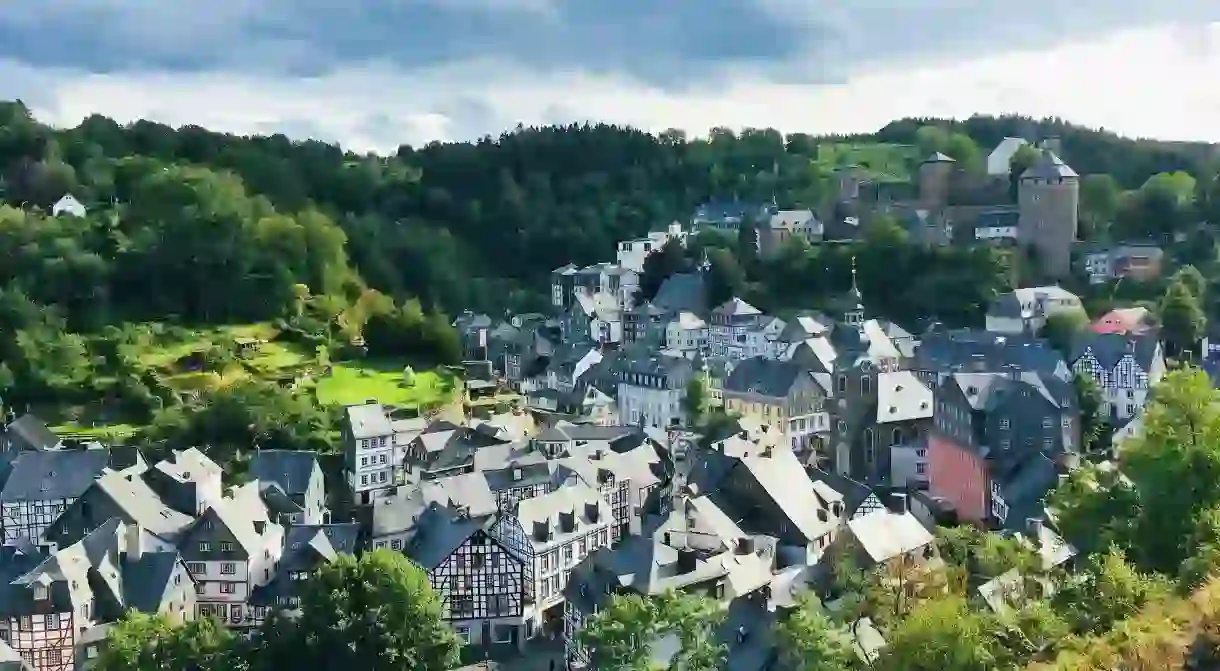The 10 Best Day Trips from Cologne

Cologne has plenty of sights to offer, but if you look beyond the city borders, you’ll find some excellent day trip destinations, including castles and palaces and historical excavation sites. Here are seven ideas on how to spend a spare day in the region.
Augustusburg and Falkenlust Palace
A mere 30 minutes from Cologne, Brühl attracts tourists with two Rococo masterpieces and UNESCO World Heritage sites. The 18th century Augustusburg and Falkenlust Palaces served as residence and hunting château respectively for the then prince-elector of Cologne. The palatial rooms wow with marble pillars, gold décor, and hand-painted murals and frescos, the parks and gardens with boxtree ornaments, fountains, and colourful flower beds.

Monschau
On a sunny day, the quaint Eifel village at the German-Belgian border is a meeting point for hikers and bikers. They stop at the local brewery for a cold Zwickel beer, or rest on the historical market square surrounded by half-timbered houses and cobblestone alleys after a day of touring the mountains and serpentine roads of the Hohes Venn and Eifel national parks. In winter, the picturesque town is often snowed in and decorated with fairy lights. Whatever the season, though, Monschau is perfect for a day trip and to snap some shots of one of Germany’s cutest villages.
Aachen
Aachen is a quick and easy train ride from Cologne and an excellent choice if you want to combine sightseeing with spa and wellness. The city near the Belgian and Dutch border lures with an imposing cathedral, which was commissioned by Charlemagne more than 1,200 years ago. Even before that, the Romans utilised the area’s hot springs and thermal water in their baths, a tradition that hasn’t broken off since. Today you can unwind and relax in the pools and treatment rooms of the Carolus Thermen day spa. Before you leave, get your hands on some Aachener Printen, the famous gingerbread-like biscuits.
Drachenburg Castle
The Drachenburg Castle in Königswinter was built as a private villa in the late 19th century, and is architecturally composed of early Gothic and Renaissance elements. Over the course of history, the castle was used first as a Catholic school, then as a Nazi elite school from 1942 forward and was heavily damaged during the bombardments of World War II. After initial repairs and repurposing, the building stood empty and started to decay. In the 1970s an investor saved the Drachenburg, which is now a landmarked building and one of the region’s major tourist attractions.

Ahr Valley
The Ahrtal is one of Germany’s leading wine regions and stretches from Cologne to Koblenz further south. Excellent red wines, hiking routes with panoramic views over the valley, and plenty of medieval castles, ruins, and monasteries wait to be explored. On a day trip, you can stroll around vineyards, learn about the area’s 2,000-year-long winemaking tradition dating back to the Roman Empire, and stop for wine tasting and tours of an estate and the wine cellar.
Bonn
Some 30 kilometres south of Cologne lies the often overlooked city of Bonn–but the charming city actually has quite a lot to offer. Built on the foundations of a Roman settlement, Bonn served as the interim capital of West Germany during the Cold War between 1949 and 1990. It’s the home of Beethoven and gummy bears, has one of the country’s most prestigious universities, a grand palace, entire boroughs lined with Gründerzeit villas, and in spring there’s a festival that celebrates the blossoming of the many cherry trees.
Neander Valley
The Neander Valley near Düsseldorf is relatively unknown abroad and yet world-famous at the same time. The valley was first recognised internationally when, in 1856, the first ever skeleton of a Neanderthal man was unearthed in a cave here. The landscape around the discovery site has since been redeveloped and transformed into an archaeological garden. The nearby Neanderthal Museum sums up the history of humankind going back more than four million years.

Dusseldorf
While Cologne is the largest city in North Rhine-Westphalia, Dusseldorf is the capital and the state’s most historic town. The two work together beautifully as a pair of Rhine city visits; Cologne’s awe-inspiring cathedral and striking modern skyline contrasting nicely with the old taverns and cobbled main streets of Old Town Dusseldorf. It only takes 20 minutes by train to hop between the two, but if you fancy taking the scenic route, you should definitely for a romantic river cruise on the Rhine. Recommended by Gethin Morgan.
Koblenz
Another riverside city well worth winding down the Rhine for is Koblenz. This lesser-known but heartwarmingly picturesque town lies just over an hour south of Cologne (by train) and sits prettily at the confluence of the rivers Rhine and Moselle. Towering over the Rhine-side is striking clifftop fortress Ehrenbreitstein, reachable via a scenic cable car ride that begins at the tip of the confluence. The Old Town, meanwhile, is situated between the two rivers and features a series of quaint squares and charming cobbled streets lined with traditional restaurants and taverns. It’s a truly charming place any time of year, but time your visit in the festive season to take advantage of one of Germany’s best Christmas markets. Recommended by Gethin Morgan.

Brussels
Since Cologne is situated near Germany’s western border, why not cross over it? Belgium and the Netherlands and both reachable within a day, so we recommend hopping on the two-hour train to Brussels, capital of Belgium. There is lots to see and do in the city – a historic town most famous for being home to the European Union – but you can’t go wrong with an afternoon spent strolling around the main square and surrounding streets, gorging on local delicacies like fine chocolate, waffles and fries, washed down with a mightily strong glass of Belgian beer. Recommended by Gethin Morgan.













